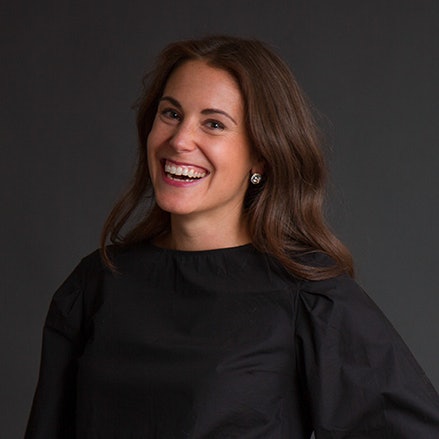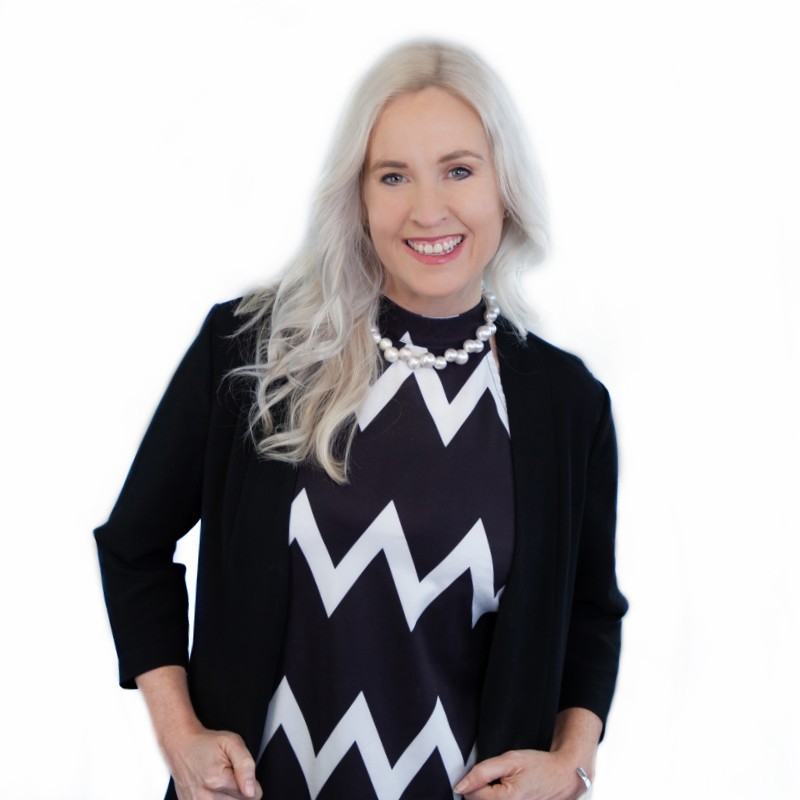Leading into a digital future should scare you out of your mind. You’ve never done it before, everything is changing, and you never know when a pandemic is going to come around.
Yet, we also need leaders to be confident and to help us believe that we can get through whatever mess we are in.
How does a digital leader hold both of those things in tension without deceiving or scaring the humans on their team?
Tiffany Sauder is the CEO of Element Three, a full service marketing agency.
Scared confidence
Tiffany says she often lives in a state of constant internal tension. As a leader, she wrestles with having to project a confident appearance to the outside world while having to deal with internal fears and doubts that are part of who she is as a person. She calls this being ‘scared confident’.
In an event of uncertainty, she says we often choose to ignore our intuition. When we do, fear builds and becomes unmanageable. The only way we can be ‘authentically confident’ is when we acknowledge fear, assess danger, and become self-aware.
Drawing from her experience with COVID, Tiffany says she was afraid of losing her company and failing as a leader. But she found herself regaining ‘authentic confidence’ by admitting uncertainty and asking questions like “What do I do to claim power over them? How do I get more information? And how do I seek counsel?”
Blindspots of digital
Tiffany says it was easier for her to connect with her team on a more human level in an office environment. But as she made the shift to digital, most of her team engagements became top-down—she spends a lot of her time reporting on issues and very little time discussing them.
She says she struggles to break out of the mold of “the boss who comes in, dumps information, and then awkwardly leaves.”
To solve this, Tiffany says she calls some of her employees every day to check in with them personally and professionally. She also makes it a point to sit in on department meetings to remind her teams about the big picture and how they contribute to it. The key, she says, is to relate to her teams at a human level and find ways to “slug through this (challenging situations) together.”
Remote onboarding
In an office environment, it’s easy for new joinees to get a sense of the company, its leadership, and create an understanding of its culture. But in a virtual environment, the essence of in-person interactions is lost—people are just profile pictures on Slack.
As a CEO, Tiffany explains that it’s her job as a leader to teach her teams how to work well with each other. Leaders need to set the tone of the digital workplace, keep their teams informed of their work styles, and proactively find methods that work for them.
Tiffany says she has put together a video for each of her new hires and asks them to follow the video up with two things—schedule a 30 minute meeting and create an open dialog about feedback and input. This helps her new hires get comfortable with scheduling time with her and create a culture that “asks for forgiveness and not permission”.
Links
Element Three’s website
Quotes
5:01 – “I ignore the fear signals. I ignore the thing in my gut until it becomes this overwhelming monster inside my head that I can’t make go away. And what I’ve learned is if I can arrest, like sort of power from the fear, from the scared part, by naming it, by looking at it squarely in the eye, then I get back power and I can sort of be courageous and be confident.”
12:03 – “I feel like in this digital environment, as the CEO, the way I’m engaging with the company all of the time is like, one way. I have something to report. Like I am the speaker, they are the audience and it’s like this one way thing. And we can be like, Hey, put your questions in the chat. They sort of do but mostly don’t, you know. And so that is where I feel like I’m trying to solve. How do I make sure that I don’t lose the sense of, I’m not up here.”
Welcome back to the digital workplace podcast. Today, our guest is Tiffany Sauder. She is the CEO of Element Three. Hey, Tiffany, how’s it going?
Good. Thank you excited to be here, Neil.
Yeah, we’re very excited to have you on. You describe yourself as a real life human being. And I hear that that’s true. So let’s do our checking around here. I’m going to ask you a question. If you could relive any year of your life, which one would it be?
Yeah, I actually have two answers if I can cheat to really prove I’m human. I’m complex. I can’t just pick one. The first one would be 2019, a little bit because it was sort of like, you know, the end of it, the end of the world as you know it. But my husband and I just did some spectacular travel. And I think having the last, you know, your time as we have, I would enjoy even more. The other would be and I would choose a decade earlier, 2009, when I went through my first economic collapse as a CEO, and I would say that almost everything was wrong. And so having a chance to sort of retread that would feel like ultimate redemption.
Yes, yeah. I feel there’s two sides to that one, right? Because on one side you want to go back and fix some of those things that would have been good. But also, like you said, the great years are great to think about too. I don’t even know. I think about my own answer. I had a time, about six years, when I lived in India. Some of that I would like to relive, some of that would be tough to relive too. But I think definitely those early days, just going back, breathing a little bit more, putting less stress on myself, and just enjoying that experience a little bit more would be great. Well, cool. Tell us a little bit about your company, what you do, and the position you’re in.
Yeah, I’m the CEO of Element Three, and I kind of wear two hats there. As CEO, it’s my job, like cast vision, make sure that we’re just really staying relevant as a company. Marketing is ever changing. And so my job is to kind of like, steer the ship, the front of the ship, like, Where are we going? What does that mean for us?
Yeah. And Marketing Three or Element Three is a full service marketing agency, right?
Yep, exactly. Yep. And then I also wear the hat of our VP of Sales and Marketing. So you know, I own ultimately the business number and building our brand and I feel like it’s sort of exercising as a marketer, very much have that role inside of Element Three. So I feel like that keeps me sharp as it relates to being a continued practitioner of the game, that my day to day job is to lead the company.
Now you do a lot of speaking as well. And one of the topics that I’ve heard you give some remarks about is this idea of ‘scared confidence’. So it’s, it’s something I think we can all resonate with and immediately it sparks something in us. But why don’t you explain a bit more what you mean by that?
Yeah. Before I start using all my words, Neil, I’d love to hear what the sort of phrase means to you, what it connects for you on. Sorry it’s in your podcast.
Yeah, no, no. I was like, there’s one guest, every once a while they do this. I think about being on a journey. I think about these big epic movies. You think about Lord of the Rings, or the Star Wars or something like that, where you’re kind of running into a situation that you know is dangerous, that you know is fraught with lots of peril, but you also have this confidence that if I stick to what I know, it’s going to work out. If I have my friends around me, it’s going to work out. If I stick to the principles, we’re going to be able to get through this. So, that’s what I feel when I hear that.
Yeah, yeah. That’s definitely a component of it. The other sort of word picture in my mind when I was getting to this idea of ‘scared confidence’ is I feel like I’m constantly living in this sort of internal tension, where it’s my job as a leader to show up, have courage and the confidence and the clarity. And yet I also battled these internal sort of fears that are also very much real and alive and equally part of who I am. And so how do I be like, authentically true to both of those things that are very much alive inside of who I am, and give both of them language so that I don’t give the fear, the scared part, too much attention. And I’ll tell you what I mean by that. This, we’ll see if this works. Think about crossing the road.
Okay.
If I said just cross the road confidently, what is the first thing that you would do?
Just look straight ahead and start walking.
Right. So, just cross it. But you’re like, I don’t know if there’s a car coming. But you’d feel more comfortable if you turn your head like your parents taught you and look both ways. Right?
Right.
Once you’ve totally assessed the danger, the fear, you can then walk authentically confident across the road. Right? What we do in our minds is, I find this inside of me is, I ignore the fear signals. I ignore the thing in my gut until it becomes this overwhelming monster inside my head that I can’t make go away. And what I’ve learned is if I can arrest, like sort of power from the fear, from the scared part, by naming it, by looking at it squarely in the eye, then I get back power and I can sort of be courageous and be confident. If we think about what we all just went through as leaders, are going through, we like to use past tense, but we’re still in the whole Coronavirus COVID world, I was afraid COVID was going to take my company from me. I was afraid companies were going to stop marketing. I was afraid I was going to fail as a leader. I was afraid I couldn’t pass this test. Right? I was afraid of all those things. Those are all really true.
And I found the speed at which I could admit that to myself, and say, these are things I’m really afraid of. What do I do to claim power over them? How do I get more information? How do I seek counsel? How do I surround myself with people who have done it before? How do I look to leaders that have sort of ‘been there done that’? Only then could I really get authentic confidence. None of us are guaranteed, we don’t get the puzzle lid, so to speak. You don’t get to see what the map looks like. But in the past, I have just ignored those sort of little nagging intuitions, like, you’re actually afraid of this, Tiffany, but you don’t want to admit it and so you’re just going to keep ignoring it.
And so this phrase for me of being ‘scared confident’ is about how do I give the fear, the scared part, have the courage to admit it so that I can move past it and get authentically confident. That doesn’t mean you take the risk out of the picture. It means that you acknowledge it. And so, to me, it’s been a very powerful construct, helped me lead in a much more authentic way, which I think as we start talking about what our leaders need to become more of, my opinion, as we lead in more remote environments, as we lead people who might be in different geographies and over different tools. I think authenticity, like the realness of that is more important than ever.
Yeah. And I really like that term, authentic confidence. Because you can contrast that with that kind of fake confidence to just say, hey, it’s going to be fine. It’s going to be fine. Don’t worry. Like, I’m just going to go forward without, like you said, without looking at those warning signs. It’s like walking out onto that road and saying, ‘No car is going to hit me’ and not looking back and forth and recognizing that it’s possible and we should have that confidence too.
Right? It’s like contrived, right? And I think that it’s not sustainable, when that’s the case. And that’s what I was feeling inside of myself as I went. You know you learn these things, because you go through the valley of despair with it. It’s like, I was faking it, because that’s what I felt like I was supposed to do. Leaders are supposed to be confident. You should have all the answers, like, people are looking for you. If you don’t know then who does? Like all this kind of stuff. And I found I was losing my own soul, my own heart, my own, like, real read on my own emotions. Because I just felt like I was in this cycle of ‘everything’s got to be okay’. It’s like, I mean, sometimes I needed to admit, it might not be. What if I did that? Like would the world come crashing down?
Let’s look at this because you’re right. The message we get from previous generations was, if you’re in leadership, you’ve got to have that stone face. You’ve got to be always ready to go forward. You can’t admit any kind of weakness. That was kind of the image that was given to us. As we leave that behind and move into a new future, is there any bit of that wisdom we do need to take with us still, in terms of how a leader shouldn’t show fear? Are there situations where that’s still true or? Like how honest are you about like, Oh, my gosh, the business might collapse? Are you telling that, sending out an email to everybody on Monday morning? What’s the balance there?
Yeah, I think that’s where the discussion is for sure. For me what I have found when I’m in the middle of wrestling through it, that is not the time for me to talk to the company at large about where I’m in. I can maybe talk to my inner circle, some people, my exec team, like, my brain is not my best friend right now. You know, I’m sort of like freaking the freak out. But what I found when I am at a place where people are waiting for me to say something, I have learned I can’t go past what I’m sure of. Meaning I’m not going to bring them on my confusion. But let’s take Coronavirus as an example. You know, we didn’t know how long this was going to go on. And so I said that to the company. I was like, I’m going to tell you the things we know and the things we don’t know. Here are the things that we don’t know. We don’t know when this is going to end. We don’t know how all of our clients are going to react. We don’t know what markets are going to accelerate and decelerate yet. These are things we don’t know.
Here’s what I can tell you. Here’s what we’re doing to get answers as fast as we can to those questions. In the next few weeks, we’re going to meet face to face with every single one of our client where like I am doing a meeting with my banker and blah, blah, blah, on what markets are, who’s asking for money to grow and who is not, like you know, trying to get a read on it. Somebody does well in every economy. And so my job as a CEO is to figure out who are the people who are growing. And I’ve got to go figure that out. So I was able to not necessarily bring answers to everybody at my company. But I could at least say, these are the questions, these are our blind spots. This is the thing that we’re doing to try to go get answers. And as we get them, we’re going to bring them to you.
And, you know, they’re asking questions in their head, like, is somebody going to lose their job? And I would say, you probably are. I mean, I know you guys are smart. You’re asking questions in your head. Like is someone going to lose their job? Yet, the truth is, I don’t know. But what I can tell you is we’re doing everything in our power to make sure that that’s not the case. I cannot promise you. I can’t make that promise to you. So what do we do? We focus on the things we can control. What can we control? These three things. And so at the end of each call, what I would get is, here’s the chaos in my mind. I’m hearing yours. I’m not going to discredit that. We are not certain about everything. But this is what we focus on. And I think that is what I learned, in leading to uncertainty, is everybody saying, What do I focus on? What is controllable? And that is what we’ve got to make sure everybody has got their arms wrapped around.
Let’s take it to a digital world now. I mean, obviously, Coronavirus itself presents this huge dilemma for leaders. But it’s also opened up this new world of digital work and where it comes from and that everyone is forced to operate in it now. As you look to the future, where do you see the unknown for leaders in a digital era? What are the areas where we’re not going to have a map for it and we need to get ready for it or as best we can to have that confidence? What are those areas you feel like we’re going to be walking into?
Yeah. I don’t know if this is what you’re wanting me to sort of where you want me to take this. But for me, I think the part that I am most wrestling with how to solve, is I feel like in this digital environment, as the CEO, the way I’m engaging with the company all of the time is like, one way. I have something to report. Like I am the speaker, they are the audience and it’s like this one way thing. And we can be like, Hey, put your questions in the chat. They sort of do but mostly don’t, you know. And so that is where I feel like I’m trying to solve. How do I make sure that I don’t lose the sense of, I’m not up here. I get that. But when I’m in the office, I’m like, how was your vacation? Like, I see this new picture on your desk, or congratulations on this thing, or I can visually see this big meeting just got over and everybody just spiraled out of the conference room. And I can be like, Oh my word, how did it go? And I can share that moment with everybody without being at work.
And now that that’s not the case. How do I find a natural cadence with people where they don’t see me just as the boss who comes in like, the voice of God, dumps information, and then awkwardly leaves the screen? You know what I mean? That’s the part to me that I’m really challenging myself in 2021, like, how do I do that. And so something I’m trying, one is, I have a goal to call at least two employees every week. And I’m going to set the expectation like, hey I’m just checking in. You’re not in trouble because it does look like the principal’s calling you for a while, you know. Like, just what’s going on, what’s going on in your world? Where are you hitting the ceiling? Personally or professionally is there like some encouragement that I can give them that day. We all have a down day. And the point is just 3 to 10 minutes, whatever they need for me just to see what’s going on.
I’m also going to try to sit in department meetings more. Again, just to sort of see what’s going on. I don’t want to necessarily contribute. Maybe helping them, reminding them, on what they’re doing ties into the bigger picture. Because again, it’s just hard to like, it’s hard to get that part of what I feel like is my job, reminding them of what we’re doing? Why does it matter? How does it tie into the big picture? How do we celebrate together? How do I have context on what’s going on in your little world when we’re all behind our computers? You know, I have addresses all over the Midwest, so.
Yeah, we’ve had this conversation about overhearing things. And when you’re in a co-located space, you do tend to just overhear things, like somebody’s talking about a vacation. You notice where the energy in the office is. You can just sense that. As a human you pick up on those things. But in a digital environment, you often don’t overhear anything. There’s just silence. You don’t have those signals out there. And so it’s another thing that we have to build back into our digital workplaces. How do I build those signals? And like you’re saying, those are great ideas you’ve given off. Just stepping into a meeting every once in a while. And obviously understanding that observer effect, that just by being there, it’s going to be different. So, you have to take that into account. But we have to do something. Because we can’t just assume. Things aren’t going to get up to you or around to you and you’re going to hear them late. There’s going to be somebody who has a big success that you don’t ever hear about, and you want to be able to celebrate that or somebody has information and you need to know about it.
I have started asking my execs. So, I went to the office yesterday and saw a couple of things. Like anything, anything going on with anybody that I need to touch in on. And that could be somebody having a tough day, or we did a bunch of work and a client just rejected it and somebody’s sort of feeling like they just got their face stuffed up. Like, you know, just the back, like anything I can do to help you lead better. And so I have started asking that question. The other thing I’ve done, we are on Slack. And so we have like the E-Three Water Cooler channel. And I try consciously to like once a week go in and kind of see and comment and like somebody put up a personality test yesterday. And like, in a different environment, I wouldn’t go take that and sort of have that shared experience. I was like, oh, here’s what I am. And I am self conscious. Like, I don’t know, if they perceive you as like, Why in the world is she in here? Or if they’re like, this is cool that she is. But again, it’s like I really have the desire to relate on a really normal level where I’m not the CEO coming in and coming out, but we’re just kind of slugging through this together.
That brings up another point that you’ve mentioned a few times. How many employees do you have with Element Three?
About 45.
About 45. So, when somebody comes in, and they’re like, let’s say you’re back in the office setting. When they come in, you’re going to meet them, they’re going to see you. They’re going to see how you interact, and they’re going to get a good vibe for you, know what they can talk about. And you seem to get a very fun atmosphere, and they know when they can tease you even on something. But if you onboard somebody in a digital format, you’re just a name. You’re just an icon. Some profile picture in Slack or something like that for a long time. And it’s hard to get away from that, Oh, she’s the CEO. Do we sit up straighter now? How do we know that? Whereas you can break down those barriers a lot easier in person in those ways. So, are there any other ways you found that you’re able to kind of help people. I don’t know if you’ve onboard anybody in the last year with that, or how to get them to feel the same level of comfort that other people who know you better do.
So we’re just doing that right now, onboarding people onto this remote environment. And I’m harkening to some, you know, time will tell if we’re successful at it. But I’ll tell you that kind of wisdom construct that I’m using around that. Somebody told me a long time ago, as a CEO, it’s your job to teach all of us but it’s your job to teach other people how to work well with you. Like, hey, this is what I kind of suck at. I’m not very organized. But I say a lot of words. Sometimes you’re not going to totally understand what I said. The best people who work well with me repeat back to me, is this what you meant? Like teach them how to work with you. So I’m bringing that concept into this remote onboarding.
And I put together a welcome video that we’re using as part of our onboarding process. And in that, I’ve said, I want you to do two things. I want you to schedule a 30 minute meeting with me after you watch this video. Because it will get them comfortable with the fact that they can put time on my schedule. And the other thing I’m telling them is, hey, look, we are in this together. Your first 100 days, you’re going to have more objectivity than any of us do about this place. And so, we welcome your feedback. And this is an ‘ask for forgiveness and not permission’ culture. So, show up, do your thing, listen well, and take ownership of your space. And I’m excited, like, I’ll be checking in excited to hear.
And I think in those first three to four months, it’s my job to set the cadence with them. Give them some activities, like put time on my calendar, that’s something you can do. Check in with them in 60 days. What’s going on? What are you learning? What have you broken for us on purpose? How are you making us better? In hopes that that starts to set the cadence. Or, hey, look like, we’re just duking this out together. Like, this is so cool. You’re on our team, and I’m just a person and let’s do this thing, so.
No, it’s great to think about that we have the opportunity to redefine these things and redefine how people can connect. Do you feel like anything that you’re learning now, just throwing this wild assumption out that one day you might be back in office, will that change how you interact in the physical world as well?
Well, it’s my suspicion that we will never be back five days a week where I mean, we were like, 2% remote. We were very much an in person company. So I think at a minimum, I’ll always be leading in a hybrid environment. Every year we do an annual kickoff where we kind of do a State of the Union address, lay out our big initiatives for the year. We did it remotely this year. The feedback from my company was it was one of the best we’ve ever done. So that gave me a ton of courage and confidence that we can do this well. We gave people breaks about every 90 minutes so they weren’t Zoom fatigued. We had a couple of breakout sessions where they were able to go and collaborate and kind of use some creative energy and then come back and be back in listening mode. So, I think we’re getting good at pacing people’s attention.
And we gave people 25 minutes, just go grab some lunch, go on a walk, come back. I think we’re getting better at knowing how you make a shared experience, even though you’re not sharing space. And that felt like a real moral win, when people are like, man, that was the best meeting we’ve done. It wasn’t like our best virtual meeting we’ve done, it was like our best meeting. And so I did get to show that we can create engagement. We should not let ourselves off the hook as leadership teams that ‘we can only hit a certain bar because we’re in a virtual environment and we’ll try our best when we’re back in person’. I think there’s ways to really reinvent this and do well in this environment.
It’s exciting. Tiffany, I love your perspective, and especially the scared confidence thing. When I think about you, I also think about you going back to that idea of this archetypal hero that’s in a situation that you know it’s going to work out. You know she’s going to get to the end and the good guys are going to win, and you guys are going to do great. So, I’m so happy that you’re in the position you’re in, and leading the people you are and have the perspective that you do. Because I think that’s what we need as leaders, are people who can lead from the front, not with this, “I know everything and we’ll definitely get there.” But saying, “I don’t know, I hope we do. And I’m pretty confident in this team. But we’re going to do our best and I think it’s going to work out.” And so, just thanks for doing what you’re doing and for being who you are and being a leader in this world.
Yeah, thank you. Appreciate you giving me a chance to kind of share our story and learn from what you’re doing as well.
Yeah, so we look forward to staying in touch with you.
Sounds great. Thanks.
Tiffany Sauder is the CEO of Element Three, a full-service marketing consultancy in Indianapolis. After taking over in 2006, she’s transformed E3 from a small creative shop into one of the fastest-growing marketing consultancies in the Midwest.
She knows that business is anything but an individual sport. So while she’s received awards like IBJ’s 40 Under 40, Junior Achievement’s Best and Brightest, and Krannert’s Burton Entrepreneurship Award, she credits much of that success to the E3ers who’ve worked hard to make Element Three a special place. Under Tiffany’s leadership, the company has appeared on the Inc. 5000 six consecutive times from 2014 to 2019, brought home a “Best of Show” ADDY Award, claimed spots on the IBJ Fast 25: Fastest Growing Businesses in 2014 and 2015, and won HubSpot’s Agency of the Year in 2012.
Outside the office, she spends time with her husband and four daughters, runs half marathons, and is practicing for the day Food Network calls to cast her on Chopped.












